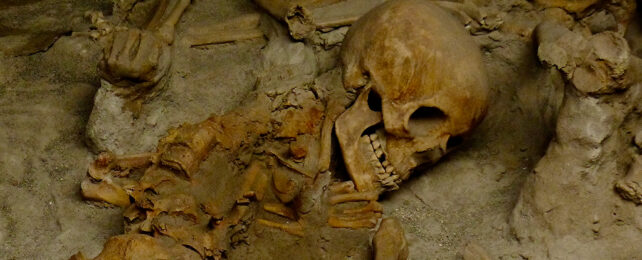When Mount Vesuvius erupted nearly 2,000 years ago, the Roman city of Pompeii and its residents were buried alive, entombed in ash. But the nearby city of Herculaneum was obliterated, and few traces of its people were ever found.
Their bodies were most likely vaporized in a searing hot blast of gas and particles, according to new research by geologists from Roma Tre University and University Federico II of Naples in Italy, who have found fresh evidence of the lethal event in carbonized wood.
In 2018, archeologists uncovered the first convincing evidence that some residents of Herculaneum met a ghastly death: their soft tissues and blood boiled in a flash when hit with extreme heat from the volcanic eruption; their skulls exploded from within.
Two years later, in 2020, archeologists described another skull unearthed at the site. It contained fragments of a glassy material that led them to believe the person's brain had been vitrified, or turned into glass.
Not everyone was convinced, however, that Herculaneum's citizens died that way. Blistering hot temperatures of around 500 °C (900 °F) could have produced the gruesome effects archeologists have observed: vitrified brains, cracked teeth, contracted limbs, charred bones, and ruptured skulls. But other evidence of soft tissue preserved on a few rib bones pointed to lower temperatures.
So geologist Alessandra Pensa of the University of Roma Tre and colleagues set out to reconstruct the extreme temperatures that hit Herculaneum's citizens when Mount Vesuvius blew its top in 79 CE.
They analyzed the amount of light reflected in 40 charred wood samples excavated in the 1960s from five different sites across the ancient city, with the samples' reflectance indicating the temperature at which the charcoal formed.
"Charcoal proved to be the only proxy capable of recording multiple, ephemeral extreme thermal events, thus revealing for the first time the real thermal impact of the 79 CE eruption," the researchers write.
This 'geothermometer' suggests that temperatures initially exceeded 500 °C and may have reached up to 555 °C when the first short-lived ash cloud from the eruption surged through Herculaneum – which is situated at the foot of Mount Vesuvius, closer than Pompeii.
These temperatures would have been "capable of causing instant death of people, while leaving only a few decimeters of ash on ground," the researchers write.
Interestingly, the highest temperature signals were detected in wood samples from the northern part of the city, at the Collegium Augustalium, where the vitrified brain was found.
Cooler temperatures previously detected on the seashore to the southwest of the town might be explained by interactions between seawater and the ash cloud when the plume first reached the coast, the researchers suggest.
Subsequent thermal waves from the eruption carried more ash and debris at slightly cooler temperatures, between 390 °C and 465 °C, and 315 °C to 350 °C.
The technical name for these successive flows is diluted pyroclastic density currents – highly turbulent and unpredictable, ground-hugging currents that travel at speeds of hundreds of meters per second. PDCs have been linked to some of the deadliest volcano disasters, including the 1902 eruption of Mount Pelée, which killed nearly 30,000 almost instantly.
Witnesses of the Mount Vesuvius eruption in Herculaneum actually described seeing clouds "traveling like streams over ground."
As the researchers note, it's not only the extremely high temperatures of diluted PDCs that can be deadly, but the combination of dynamic pressure, acidic gases, and suffocation from ash inhalation.
Although little remains of Herculaneum today, the town's dramatic end serves as a warning of Mount Vesuvius' seething potential to erupt again.
The researchers suggest that buildings within the 'red zone' of Mount Vesuvius – where approximately 700,000 people live – should be reinforced to shelter residents from the thermal impacts of any potential future eruptions, should they not be able to evacuate in time.
"The lethal impact documented for diluted pyroclastic density currents produced during ancient and recent volcanic eruptions suggests that such hazard deserves greater consideration at Vesuvius and elsewhere," the researchers write.
In the event of another short-lived ash cloud surge, "potential for survival critically depends on the ability of shelters to prevent infiltration of the hot dusty gas," they conclude.
The research has been published in Scientific Reports.
